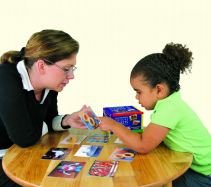Just using realistic pictures to interact with and teach children is not enough. The key is in the specific ways that you use the pictures to build vocabulary, communication, literacy and critical thinking skills. The following chapters will introduce many techniques and teaching ideas across broad instructional categories, but one thing is clear: interaction is paramount. Active strategies that engage children and encourage them to participate in discussion about the picture are much better than just offering up passive descriptions.
 Having a child name a picture (as opposed to naming it for the child) requires the child to be more involved (Ninio, 1983). Consider the difference between driving to a new location or riding along as a passenger; the more engaged you are in the process, the more likely you will remember how to get there in the future!
Having a child name a picture (as opposed to naming it for the child) requires the child to be more involved (Ninio, 1983). Consider the difference between driving to a new location or riding along as a passenger; the more engaged you are in the process, the more likely you will remember how to get there in the future!
Studies show that when a mother and child look at basic picture books, the mothers who engage their children with more interactive strategies, like linking the pictures to other concepts (“What color is this?” “How many are there?” “How are these two alike?”), are more likely to have children who have higher tested vocabulary scores (Winn, 2002).
Want more tips on how to get them engaged? Read more on how to engage kids with pictures.
